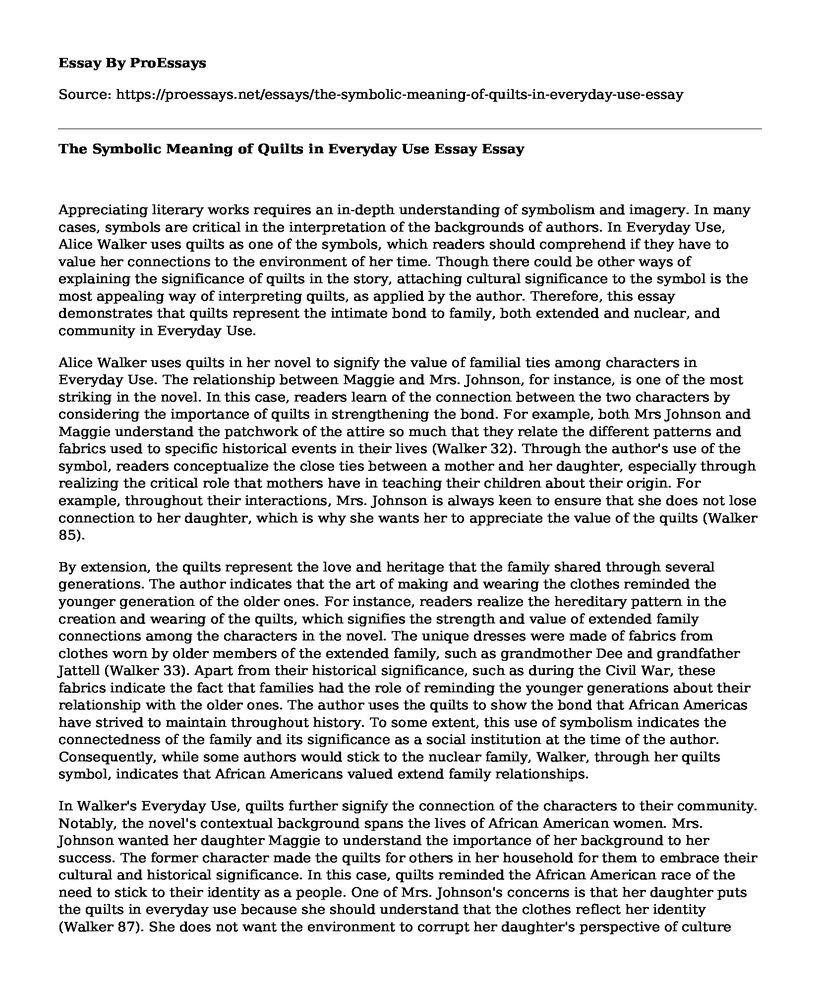Appreciating literary works requires an in-depth understanding of symbolism and imagery. In many cases, symbols are critical in the interpretation of the backgrounds of authors. In Everyday Use, Alice Walker uses quilts as one of the symbols, which readers should comprehend if they have to value her connections to the environment of her time. Though there could be other ways of explaining the significance of quilts in the story, attaching cultural significance to the symbol is the most appealing way of interpreting quilts, as applied by the author. Therefore, this essay demonstrates that quilts represent the intimate bond to family, both extended and nuclear, and community in Everyday Use.
Alice Walker uses quilts in her novel to signify the value of familial ties among characters in Everyday Use. The relationship between Maggie and Mrs. Johnson, for instance, is one of the most striking in the novel. In this case, readers learn of the connection between the two characters by considering the importance of quilts in strengthening the bond. For example, both Mrs Johnson and Maggie understand the patchwork of the attire so much that they relate the different patterns and fabrics used to specific historical events in their lives (Walker 32). Through the author's use of the symbol, readers conceptualize the close ties between a mother and her daughter, especially through realizing the critical role that mothers have in teaching their children about their origin. For example, throughout their interactions, Mrs. Johnson is always keen to ensure that she does not lose connection to her daughter, which is why she wants her to appreciate the value of the quilts (Walker 85).
By extension, the quilts represent the love and heritage that the family shared through several generations. The author indicates that the art of making and wearing the clothes reminded the younger generation of the older ones. For instance, readers realize the hereditary pattern in the creation and wearing of the quilts, which signifies the strength and value of extended family connections among the characters in the novel. The unique dresses were made of fabrics from clothes worn by older members of the extended family, such as grandmother Dee and grandfather Jattell (Walker 33). Apart from their historical significance, such as during the Civil War, these fabrics indicate the fact that families had the role of reminding the younger generations about their relationship with the older ones. The author uses the quilts to show the bond that African Americas have strived to maintain throughout history. To some extent, this use of symbolism indicates the connectedness of the family and its significance as a social institution at the time of the author. Consequently, while some authors would stick to the nuclear family, Walker, through her quilts symbol, indicates that African Americans valued extend family relationships.
In Walker's Everyday Use, quilts further signify the connection of the characters to their community. Notably, the novel's contextual background spans the lives of African American women. Mrs. Johnson wanted her daughter Maggie to understand the importance of her background to her success. The former character made the quilts for others in her household for them to embrace their cultural and historical significance. In this case, quilts reminded the African American race of the need to stick to their identity as a people. One of Mrs. Johnson's concerns is that her daughter puts the quilts in everyday use because she should understand that the clothes reflect her identity (Walker 87). She does not want the environment to corrupt her daughter's perspective of culture because it would mean that she might forget about her origin. It could be for this reason, that Mrs. Johnson likes it when Maggie attempts to convince Dee into liking the quilts prepared for her when she was living for college (Walker 33). Through these examples, readers of the novel understand the usefulness of quilts in suggesting the relationship between individuals and their community.Conclusion
Conclusively, Alice Walker chose quilts to represent the value of family connections during her time, especially among African Americans. Through her persistent painting of Mrs. Johnson as a mother figure in Everyday Use, Walker demonstrates the fact that older society members had the duty of teaching the younger ones about the need to stick to their family identity. The novel stresses the criticality of nuclear familial connections while indicating the role that older members have in connecting the younger ones to their family heritage. Readers of the story learn the fact that African Americans needed to stick to their identity during the time of the author, and quilts were a perfect way of representing the cultural and historical personalities of the characters.
Work Cited
Walker, Alice. Everyday Use. Rutgers University Press, 1994.
Cite this page
The Symbolic Meaning of Quilts in Everyday Use Essay. (2022, Mar 09). Retrieved from https://proessays.net/essays/the-symbolic-meaning-of-quilts-in-everyday-use-essay
If you are the original author of this essay and no longer wish to have it published on the ProEssays website, please click below to request its removal:
- Situations Involving the Use of Communication Technology Tools Other Than Social Media
- How It Feels to Be Colored Me by Zora Hurston Analysis Paper Example
- Essay on Comparing Picasso & Van Gogh: Artistic Paths & Styles
- Movie Analysis Essay on The Last Samurai
- Essay Example on Sonnet XX: A Young Man's Dual Nature and Character
- Pornography's Impact on Modern Society: Examined - Essay Sample
- Essay Example on Paul's Claim of Luck in The Rocking Horse Winner







